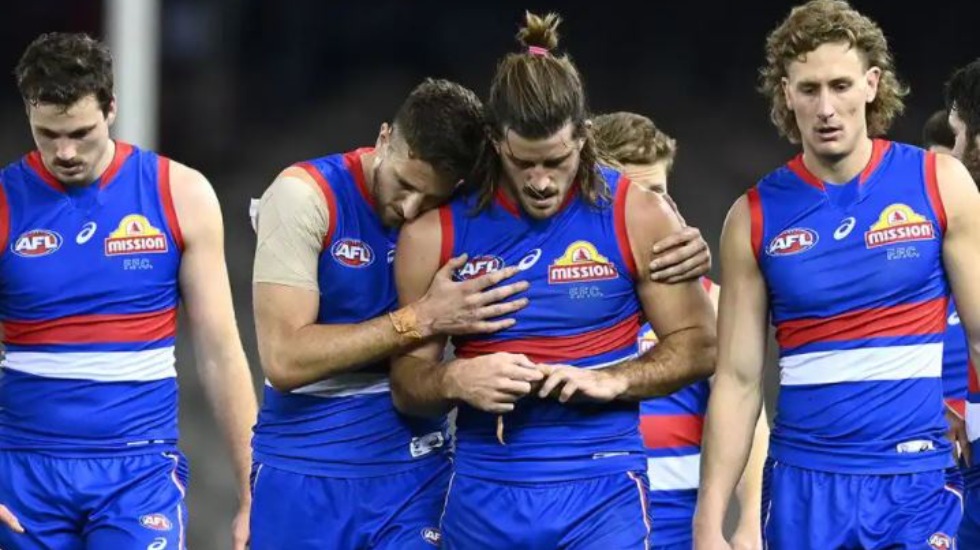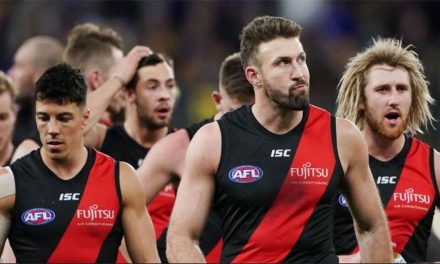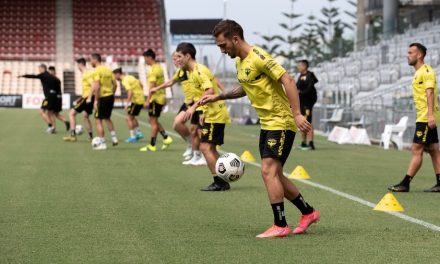Marcus Bontempelli consoles the injured Josh Bruce after the top-of-the-ladder Bulldogs’ loss to Essendon. Photo: AFL MEDIA
Another season, another multi-pronged flight for a minor premiership that if modern history has anything to tell us, will probably mean a whole lot of nothing.
On Sunday, the Western Bulldogs had a golden chance to put themselves in an almost unassailable position to win the club’s first ever minor gong, but blew it against a more committed Essendon outfit.
Last Friday night, Geelong also froze in the bright lights, knocked off by the Giants in the upset of the season, while Melbourne on Monday night jumped from fourth spot to the top of the ladder, for now at least, after overcoming a lightning delay to hang on for a win against West Coast in Perth.
Yet the big question for the Demons, the Bulldogs, Geelong and even Port Adelaide is a pretty blunt one: So what?
Sure, a minor premiership is a nice, quirky curio to file away, kind of like your tea-towel from Coffs Harbour, yet in recent years, finishing top has had absolutely no correlation with ultimate glory. In fact, if anything, it’s proven to be something of a millstone.
Let’s have a look at why this is the case, and whether this year has the potential to be at all different.
So, what’s going on?
Well, simply put, minor premiers have stopped winning premierships.
We’re currently on a seven-season streak without a minor premier converting their home and away excellence into a flag, easily the longest streak in AFL/VFL history.
Previously, the longest stretch of a minor premier failing to collect the late September chocolates was four seasons between 1975 and 1978, while between 1987 and 2014, 24 of the league’s 28 minor champs at least made the grand final – with a dozen of those crowned winners. The AFL’s last three minor premiers haven’t even reached the grand final.
Why is this happening?
Lots of reasons. We’re still not even close to a competition which has anything remotely resembling fixture equity, instead living within a league that’s increasingly cannon-balling all of its 18 teams all around the country and pitting them disproportionately against an array of good, bad and indifferent clubs.
For instance this season, Carlton and Collingwood have left Victoria just four times, while North Melbourne has played 10 of its games outside the state. As for the Giants, they’ve played 15 of their 20 games outside NSW and in 12 different stadiums, no less.
Port Adelaide and Brisbane have played a league-low seven games against top-eight opponents so far, while poor old St Kilda have had 11 such assignments, the likes of which might ultimately prove the difference between missing out on a finals spot.
PLEASE HELP US CONTINUE TO THRIVE BY BECOMING AN OFFICIAL FOOTYOLOGY PATRON. JUST CLICK THIS LINK.
When it comes to the organisation of its actual competition, the AFL home and away season is more akin to a rickety ghost train, and one which is increasingly providing merely an overview of who’s good and who’s not by the time September arrives.
Remember the titans
The never-ending travel and slipshod scheduling haven’t helped, but neither has the sudden disappearance of the regular season behemoth.
Prior to our increasingly zany AFL landscape, and indeed these Covid times, it wasn’t uncommon for a team to run absolute roughshod over the competition, and usually also able to parlay that dominance into a premiership.
In the AFL era, we’ve had a few teams basically take the piss out of the home-and-away season. Think West Coast in 1991, Carlton in 1995, Essendon in 2000 and Geelong in both 2007 and 2008, all of whom finished top with at least a three-game gap on the rest of the league, and who all used that menace to charge to a grand final berth at a minimum.
These days, it’s becoming harder and harder to pry the best teams apart by the end of the AFL season. In fact, six of the last nine minor premierships have been decided by percentage only, while 10 of the last 12 regular season champs have done so with less than a one-game gap on the chasing pack.
The closest we’ve come to an even remotely dominant home-and-away team in recent times was Richmond in 2018, and even then, Collingwood’s Mason Cox saw to it that their journey ended on preliminary final weekend.
While some like to suggest there was a fluky element to the Western Bulldogs winning the 2016 flag, it’s worth remembering that while the Dogs did finish seventh after 23 rounds, they were just a couple of games off top spot, while a 15-7 record is quite often good enough for a top-four position.
The point is that the home-and-away season is getting tighter and tighter and acting more as a dressed-up entree than a nourishing main meal, a reality of which Geelong fans are acutely aware.
Will this year be different?
Maybe, though don’t count it.
We’ve played 21 rounds and we still have four teams split by just half-a-game, while we’re still seeing our relatively “best” teams routinely fail against average to terrible teams.
This extreme tightness could be a godsend for a team on the fringes of the top four, while a team like Sydney, which has have beaten both Geelong and the Bulldogs this year, might fancy itself as just the second team in the last 23 years to win a premiership without the benefit of a double chance.
While we can accept there’s not a heap of weight to how the ladder ends up looking, it does at least pave the way for an almighty finals series, the likes of which always produces the league’s definitive champion.
Even if the identity of that champion isn’t the least bit obvious just yet.
You can read more of James Rosewarne’s work at STATS INSIDER











